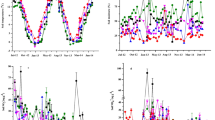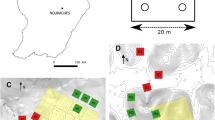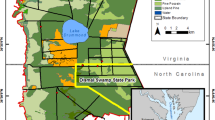Abstract
In order to identify the effects of land-use/cover types, soil types and soil properties on the soil-atmosphere exchange of greenhouse gases (GHG) in semiarid grasslands as well as provide a reliable estimate of the midsummer GHG budget, nitrous oxide (N2O), methane (CH4) and carbon dioxide (CO2) fluxes of soil cores from 30 representative sites were determined in the upper Xilin River catchment in Inner Mongolia. The soil N2O emissions across all of the investigated sites ranged from 0.18 to 21.8 μg N m-2 h-1, with a mean of 3.4 μg N m-2 h-1 and a coefficient of variation (CV, which is given as a percentage ratio of one standard deviation to the mean) as large as 130%. CH4 fluxes ranged from -88.6 to 2,782.8 μg C m-2 h-1 (with a CV of 849%). Net CH4 emissions were only observed from cores taken from a marshland site, whereas all of the other 29 investigated sites showed net CH4 uptake (mean: -33.3 μg C m-2 h-1). CO2 emissions from all sites ranged from 3.6 to 109.3 mg C m-2 h-1, with a mean value of 37.4 mg C m-2 h-1 and a CV of 66%. Soil moisture primarily and positively regulated the spatial variability in N2O and CO2 emissions (R2 = 0.15–0.28, P < 0.05). The spatial variation of N2O emissions was also influenced by soil inorganic N contents (P < 0.05). By simply up-scaling the site measurements by the various land-use/cover types to the entire catchment area (3,900 km2), the fluxes of N2O, CH4 and CO2 at the time of sampling (mid-summer 2007) were estimated at 29 t CO2-C-eq d-1, -26 t CO2-C-eq d-1 and 3,223 t C d-1, respectively. This suggests that, in terms of assessing the spatial variability of total GHG fluxes from the soils at a semiarid catchment/region, intensive studies may focus on CO2 exchange, which is dominating the global warming potential of midsummer soil-atmosphere GHG fluxes. In addition, average GHG fluxes in midsummer, weighted by the areal extent of these land-use/cover types in the region, were approximately -30.0 μg C m-2 h-1 for CH4, 2.4 μg N m-2 h-1 for N2O and 34.5 mg C m-2 h-1 for CO2.




Similar content being viewed by others
References
Bouwman AF, Vanderhoek KW, Olivier JGJ (1995) Uncertainties in the global source distribution of nitrous oxide. J Geophys Res 100:2785–2800
Brus DJ, de Gruijter JJ (1997) Random sampling or geostatistical modelling? Choosing between design-based and model-based sampling strategies for soil (with discussion). Geoderma 80:1–44
Buyanovsky GA, Kucera CL, Wagner GH (1987) Comparative analysis of carbon dynamics in native and cultivated ecosystems. Ecology 68:2023–2031
Chapius-Lardy L, Wrage N, Metay A, Chotte J, Bernoux M (2007) Soils, a sink for N2O? A review. Global Change Biol 13:1–17
Chen G, Huang B, Xu H, Zhang Y, Huang G, Yu K, Hou A, Du R, Han S, VanCleemput O (2000) Nitrous oxide emissions from terrestrial ecosystems in China. Chemosphere-Global Change Sci 2:373–378
Conant RT, Klopatek JM, Klopatek CC (2000) Environmental factors controlling soil respiration in three semiarid ecosystems. Soil Sci Soc Am J 64:383–390
Corre MD, van Kessel C, Pennock DJ (1996) Landscape and seasonal patterns of nitrous oxide emissions in a semiarid region. Soil Sci Soc Am J 60:1806–1815
Cui XY, Chen SQ, Chen ZZ (2000) CO2 release from typical stipa grandis grassland soil. Chin J Appl Ecol 11:390–394
Denmead OT, Ereney JR, Simpson JR (1979) Studies of nitrous oxide emission from a grass sward. Soil Sci Soc Am J 43:726–728
Du R, Lu DR, Wang GC (2006) Diurnal, seasonal and inter-annual variations of N2O fluxes from native semi-arid grassland soils of Inner Mongolia. Soil Biol Biochem 38:3474–3482
Fang Y, Gundersen P, Zhang W, Zhou G, Christiansen JR, Mo J, Dong S, Zhang T (2009) Soil-atmosphere exchange of N2O, CO2 and CH4 along a slope of an evergreen broad-leaved forest in southern China. Plant Soil 319:37–48
Frank AB, Liebig MA, Tanaka DL (2006) Management effects on soil CO2 efflux in northern semiarid grassland and cropland. Soil Till Res 89:78–85
Frolking SE, Mosier AR, Ojima DS, Li C, Parton WJ, Potter CS, Priesack E, Stenger R, Haberbosch C, Dorsch P, Flessa H, Smith KA (1998) Comparison of N2O emissions from soils at three temperate agricultural sites: simulations of year-round measurements by four models. Nutr Cycl Agroecosyst 52:77–105
Galbally IE, Kirstine WV, Meyer CP, Wang YP (2008) Soil-atmosphere trace gas exchange in semiarid and arid zones. J Environ Qual 37:599–607
Glatzel S, Stahr K (2001) Methane and nitrous oxide exchange in differently fertilized grassland in southern Germany. Plant Soil 231:21–35
Granli T, Bockman OC (1994) Nitrous oxide from agriculture. Norweg J Agr Sci. Norsk Hydro, Oslo, pp 57–58, Supplement No. 12
Holst J, Liu CY, Brüggemann N, Butterbach-Bahl K, Zheng XH, Wang YS, Han SH, Yao ZS, Yue J, Han XG (2007a) Microbial N turnover and N-Oxide (N2O/NO/NO2) fluxes in semi-arid grassland of Inner Mongolia. Ecosystems 10:623–634
Holst J, Liu CY, Yao ZS, Brüggemann N, Zheng XH, Han XG, Butterbach-Bahl K (2007b) Importance of point sources on regional nitrous oxide fluxes in semi-arid steppe of Inner Mongolia, China. Plant Soil 296:209–226
IPCC (Intergovernmental Panel on Climate Change) (2007) Climate Change 2007: The physical science basis, contribution of working group I to the fourth assessment report of the intergovernmental panel on climate change Solomon S, Qin D, Manning M, Chen Z, Marquis M, Averyt K B, Tignor M, and Miller H L (eds.), Cambridge University Press, Cambridge, United Kingdom and New York, NY, USA
Ishizuka S, Tsuruta H, Murdiyarso D (2002) An intensive field study on CO2, CH4 and N2O emissions and soil properties at four land-use types in Sumatra, Indonesia. Global Biogeochem Cycles 16:1049. doi:10.1029/2001GB001614
Keller M, Reiners WA (1994) Soil-atmosphere exchange of nitrous oxide, nitric oxide, and methane under secondary succession of pasture to forest in the Atlantic lowlands of Costa Rica. Global Biogeochem Cycles 8:399–409
Li LH, Wang QB, Bai YF, Zhou GS, Xing XR (2000) Soil respiration of a Leymus chinensis grassland stand in the Xilin River Basin as affected by over-grazing and climate. Acta Phytoecological Sinica 24:680–686
Lilly A, Ball BC, McTaggart IP, DeGroote J (2009) Spatial modeling of nitrous oxide emissions at the national scale using soil, climate and land use information. Global Change Biol 15:2321–2332
Liu C (2007) The study of biosphere-atmosphere exchange of CH4, N2O and NOx in a semi-arid steppe in Inner Mongolia, China. Ph. D. Thesis, Institute of Atmospheric Physics, Chinese Academy of Sciences, Beijing, China
Liu C, Holst J, Bruggemann N, Butterbach-Bahl K, Yao Z, Yue J, Han S, Han X, Krummelbeind J, Hornd R, Zheng X (2007) Grazing reduces methane uptake by soils in a semi-arid steppe in Inner Mongolia, China. Atmos Environ 41:5948–5958
Liu C, Holst J, Yao Z, Bruggemann N, Butterbach-Bahl K, Han S, Han X, Tas B, Susenbeth A, Zheng X (2009a) Growing season methane budget of an Inner Mongolian steppe. Atmos Environ 43:3086–3095
Liu WX, Zhang Z, Wan SQ (2009b) Predominant role of water in regulating soil and microbial respiration and their responses to climate change in a semiarid grassland. Global Change Biol 15:184–195
Maestre FT, Cortina J (2003) Small-scale spatial variation in soil CO2 efflux in a Mediterranean semiarid steppe. Appl Soil Ecol 23:199–209
Matson PA, Vitousek PM, Livingston GP, Swanberg NA (1990) Sources of variations in nitrous oxide flux from Amazonian ecosystems. J Geophys Res 95:16789–16798
Matson PA, Volkmann C, Coppinger K, Reiners WA (1991) Annual nitrous oxide flux and soil nitrogen characteristics in sagebrush steppe ecosystems. Biogeochemistry 14:1–12
Minasny B, McBratney AB (2007) Incorporating taxonomic distance into spatial prediction and digital mapping of soil classes. Geoderma 142:285–293
Mosier A, Schimel D, Valentine D, Bronson K, Parton W (1991) Methane and nitrous oxide fluxes in native, fertilized and cultivated grasslands. Nature 350:330–332
Mosier AR, Parton WJ, Valentine DW, Ojima DS, Schimel DS, Delgada JA (1996) CH4 and N2O fluxes in the Colorado shortgrass steppe 1. Impact of landscape and nitrogen addition. Global Biogeochem Cycles 10:387–399
Mosier AR, Parton WJ, Valentine DW, Ojima DS, Schimel DS, Heinemeyer O (1997) CH4 and N2O fluxes in the Colorado shortgrass steppe 2. Long-term impact of land use change. Global Biogeochem Cycles 11:29–42
Mummey DL, Smith JL, Bolton H Jr (1994) Nitrous oxide flux from a shrub-steppe ecosystems: sources and regulation. Soil Biol Biochem 26:29–286
Parton WJ, Mosier AR, Schimel DS (1988) Rates and Pathways of nitrous oxide production in a shortgrass steppe. Biogeochemistry 6:45–58
Qi YC, Dong YS, Liu JY, Domroes M, Geng YB, Liu LX, Liu XR, Yang XH (2007) Effect of the conversion of grassland to spring wheat field on the CO2 emission characteristics in Inner Mongolia, China. Soil Till Res 94:310–320
Schimel JP, Gulledge J (1998) Microbial community structure and global trace gases. Global Change Biol 4:745–758
Schimel JP, Gulledge JM, Clein-Curley JS, Lindstrom JE, Braddock JF (1999) Moisture effects on microbial activity and community structure in decomposing birch litter in the Alaskan taiga. Soil Biol Biochem 31:831–838
Six J, Conant RT, Paul EA, Paustian K (2002) Stabilization mechanisms of soil organic matter: implications for C-saturation of soils. Plant Soil 241:155–176
Skiba UM, Sheppard LJ, Macdonald J, Fowler D (1998) Some key environmental variables controlling nitrous oxide emissions from agricultural and semi-natural soils in Scotland. Atmos Environ 32:3311–3320
Smith KA, Ball T, Conen F, Dobbie KE, Massheder J, Rey A (2003) Exchange of greenhouse gases between soil and atmosphere: interactions of soil physical factors and biological processes. Eur J Soil Sci 54:779–791
Sozanska M, Skiba U, Metcalfe S (2002) Developing an inventory of N2O emissions from British soils. Atmos Envion 36:987–998
Steffens M, Kölbl A, Giese M, Hoffmann C, Totsche KU, Breuer L, Kögel-Knabner I (2009) Spatial variability of topsoils and vegetation in a grazed steppe ecosystem in Inner Mongolia (PR China). J Plant Nutr Soil Sci 172:78–90
Striegl RG, McConnaughey TA, Thorstenson OC, Weeks EP, Woodward JC (1992) Consumption of atmospheric methane by desert soils. Nature 357:145–147
Turner DA, Chen D, Galbally IE, Leuning R, Edis RB, Li Y, Kelly K, Phillips F (2008) Spatial variability of nitrous oxide emissions from an Australian irrigated dairy pasture. Plant Soil 309:77–88
Velthof GL, Oenema O (1995) Nitrous oxide fluxes from grassland in Netherlands: II. Effects of soil type, nitrogen fertilizer application and grazing. Eur J Soil Sci 46:531–540
Wang YS, Wang YH (2003) Quick measurement of CH4, CO2 and N2O emissions from a short-plant ecosystem. Adv Atmos Sci 20:842–844
Wang W, Fang J (2009) Soil respiration and human effects on global grasslands. Global Planet Change 67:20–28
Wang Y, Ji B, Huang Y, Hu Y, Wang Y (2001) Effects of grazing and cultivating on emission of nitrous oxide, carbon dioxide and uptake of methane from Grasslands. Environ Sci 22:7–13
Wang GC, Du R, Kong QX, Lu DR (2004) Experimental study on soil respiration in temperate grassland in China. Chinese Science Bulletin 49:642–646
Wang Y, Xue M, Zheng X, Ji B, Du R, Wang Y (2005a) Effects of environmental factors on N2O emission from and CH4 uptake by the typical grasslands in the Inner Mongolia. Chemosphere 58:205–215
Wang ZP, Han XG, Li LH, Chen QS, Duan Y, Cheng WX (2005b) Methane emission from small wetlands and implications for semiarid region budgets. J Geophys Res 110, doi:10.1029/2004JD005548
Wang ZP, Song Y, Gulledge J, Yu Q, Liu HS, Han XG (2009) China’s grazed temperate grasslands are a net source of atmospheric methane. Atmos Environ 43:2148–2153
Williams MA, Rice CW, Owensby CE (2000) Carbon dynamics and microbial activity in tallgrass prairie exposed to elevated CO2 for 8 years. Plant Soil 227:127–137
Wilson J, Gallant J (eds) (2000) Terrain Analysis: Principles and Applications. Wiley, New York
Xu M, Qi Y (2001) Spatial and seasonal variations of Q10 determined by soil respiration measurements at a Sierra Nevadan forest. Global Biogeochem Cycles 15:687–696
Xu-Ri WYS, Zheng XH, Ji BM, Wang MX (2003) A comparison between measured and modeled N2O emissions from Inner Mongolia semi-arid grassland. Plant Soil 255:513–528
Yamulki S, Harrison RM, Goulding KWT, Webster CP (1997) N2O, NO and NO2 fluxes from a grassland: effect of soil pH. Soil Biol Biochem 29:1199–1208
Zak DR, Pregitzer KR, Curtis PS, Teeri JA, Fogel R, Randlett DL (1993) Elevated CO2 and feedback between carbon and nitrogen cycles. Plant Soil 151:105–107
Zhang JF, Han XG (2008) N2O emission from the semi-arid ecosystem under mineral fertilizer (urea and superphosphate) and increased precipitation in northern China. Atmos Environ 42:291–302
Zhang Y, Li LH, Wang YF, Tang F, Chen QS, Yang J, Yuan YZ, Dong YS (2003) Comparison of soil respiration in two grass-dominated communities in the Xilin River Basin: correlations and controls. Acta Botanica Sinica 45:1024–1029
Zheng X, Mei B, Wang YH, Xie B, Wang YS, Dong H, Xu H, Chen G, Cai Z, Yue J, Gu J, Su F, Zou J, Zhu J (2008) Quantification of N2O fluxes from soil-plant systems may be biased by the applied gas chromatograph methodology. Plant Soil 311:211–234
Zou CJ, Wang KY, Wang TH, Xu WD (2007) Overgrazing and soil carbon dynamics in eastern Inner Mongolia of China. Ecol Res 22:135–142
Acknowledgements
This study was financially supported by the National Natural Science Foundation of China (40805061, 40425010), the German Research Foundation (DFG) (Research Group MAGIM, FG 536) and the Helmholtz-CAS joint laboratory project ENTRANCE. We thank Ms. Zhihong Yu for her assistance in gas sampling and analysis. Thanks are also given to the Inner Mongolia Grassland Ecosystem Research Station for providing meteorological data.
Author information
Authors and Affiliations
Corresponding author
Additional information
Responsible Editor: Per Ambus.
Rights and permissions
About this article
Cite this article
Yao, Z., Wolf, B., Chen, W. et al. Spatial variability of N2O, CH4 and CO2 fluxes within the Xilin River catchment of Inner Mongolia, China: a soil core study. Plant Soil 331, 341–359 (2010). https://doi.org/10.1007/s11104-009-0257-x
Received:
Accepted:
Published:
Issue Date:
DOI: https://doi.org/10.1007/s11104-009-0257-x




